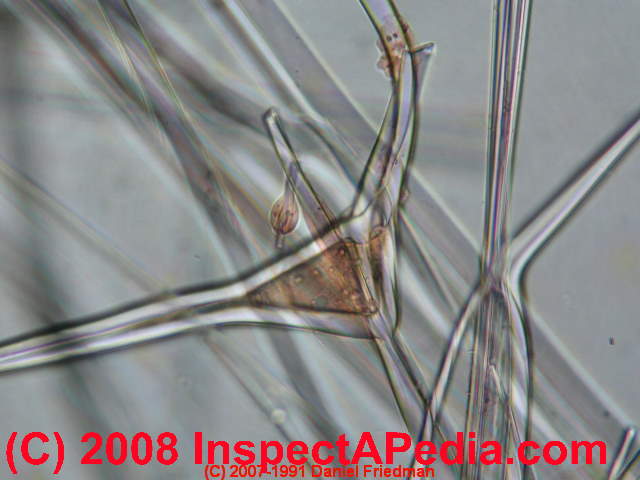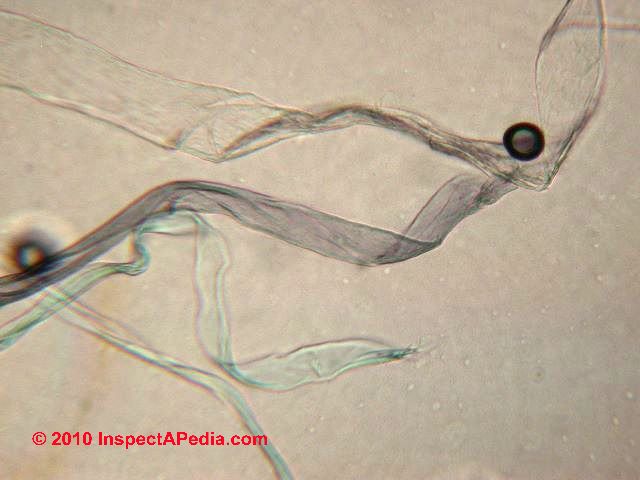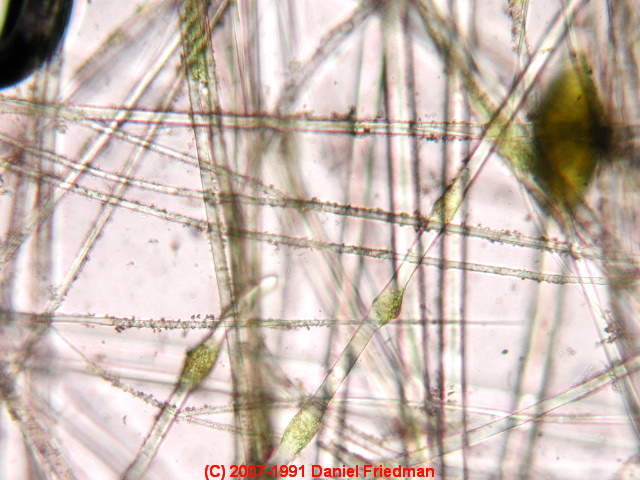 Fiberglass Particle Identification in the Fiberglass Test Laboratory
Fiberglass Particle Identification in the Fiberglass Test Laboratory
- POST a QUESTION or COMMENT about lab procedures for the identification of large & small fiberglass fragments in air & dust samples from buildings
Lab procedures for fiberglass dust testing:
This document provides forensic laboratory procedural details for the laboratory identification of fiberglass hazards in air or in settled dust samples collected in residential and light-commercial buildings.
Photos here of insulation in our forensic lab are by Daniel Friedman, forensic microscopist.
InspectAPedia tolerates no conflicts of interest. We have no relationship with advertisers, products, or services discussed at this website.
- Daniel Friedman, Publisher/Editor/Author - See WHO ARE WE?
Laboratory Identification of Fiberglass Fibers & Fragments
 Fiberglass fragments in air, dust, or material samples are easily identified
Fiberglass fragments in air, dust, or material samples are easily identified
in the forensic laboratory using light and polarized light microscopy and
common slide preparation techniques.
While glass fibers can be identified using Cargille(R) certified refractive index liquids, it is easier and faster to examine fibers prepared in almost any common slide mounting solution by looking for the following features:
- Smooth sided manmade fibers
which may appear in a wide variety of diameters and lengths, but with a characteristic concoidal fracture on the fiber end is key in laboratory identification of fiberglass fragments in air samples or settled dust samples from buildings where screening for fiberglass dust is required - Presence of colored resin binder
on fiber lengths or where fibers cross is another identifying characteristic of fiberglass insulation - The disappearance of these fiberglass fibers from view
in a light microscope when viewed with crossed polars also is used to confirm that glass fibers are present - Presence of concoidal fractures
on the ends of fibers is evidence of glass or fiberglass
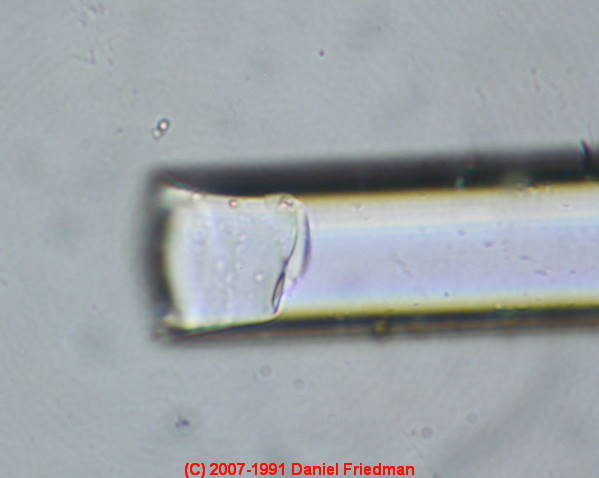
The two lab photographs of fiberglass insulation just above show, from left, the characteristic concoidal fracture at the end of a fiberglass fiber,
and resinous material used as a binder in fiberglass insulation.
The resin binder in fiberglass insulation can appear in various colors and which gives
fiberglass its individual characteristic color.
Determining the source of fiberglass particles found in a building:
It may be possible to identify the manufacturer of or at least the source of fiberglass fibers found in a building by comparing the color of resin identified in the microscope with colors observed by visual inspection of fiberglass installed in different building areas.
Identifying fiberglass resins and mineral wool insulation:
The left hand lab photo of fiberglass show below provides two examples of resinous binder in fiberglass insulation at a lower magnification of about 300x, with the left, triangular resin particle having been bound to two intersecting glass fibers.
Notice the considerable variation in fiberglass fiber diameter in this photo - the fibers in this photo might be from different sources as not only are they characteristically different by metrics, but their resins are of different color.
Problems in identifying very small fiberglass fragments in air and dust samples:
Our own field investigations find that fiberglass particles are quite common in indoor air.
Unless the forensic particle laboratory is making a point of counting small fiberglass fragments in indoor air or dust samples, only a large-particle count may be provided and the presence and potential effects of fiberglass dust may be underestimated.
Furthermore, proper lab procedure and use of mountants with an appropriate refractive index to see glass fragments is critical as otherwise such particles may simply be invisible when viewed using conventional slide preparation methods.
Mineral wool insulation: The right hand photo shown below shows
displays a resin binder and thin, varying-diameter fibers of glass mineral wool insulation.
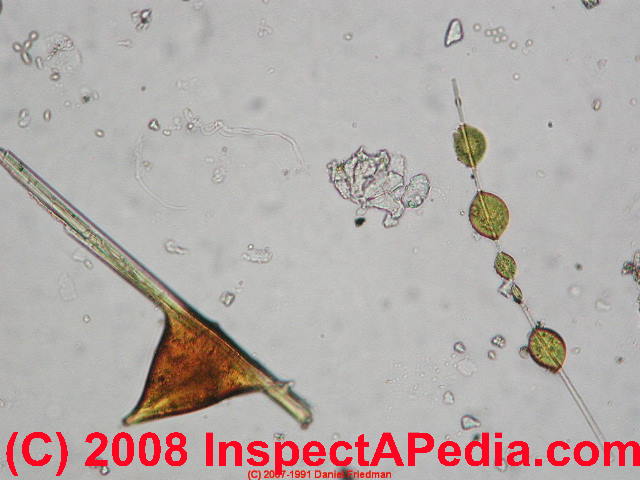
Under polarized light using crossed polars, the glass fibers in these photos will simply disappear from view.
(Photo not shown: phase contrast microscopy or use of special mounting fluids with an appropriate refractive index may be needed especially to identify small fiberglass fragments.)
Photographs of Unbonded Fiberglass Insulation - "Blowing Wools"
Above is a sample "blowing wool" building insulation.
Below we show a macro photograph of this white blown-in unbonded InsulSafe® building insulation sold by CertainTeed and provided by a homeowner who asked our lab to study dust samples from her home.
Below under the next heading is the same insulation shown in the stereo microscope at about 20x, and below the same material is magnified to 720x.
Identifying Contents of House Dust to Screen for Building Insulation

Above we show a 720x micro-photograph of white blown-in unbonded InsulSafe® building insulation sold by CertainTeed.
Below our photo shows the dominant particles in the dust sample from the home under study (NOT fiberglass).
Magnified to 720x the fibers we found were primarily cotton, with some linen and a few synthetic fabric fibers.
There was virtually none of the insulation fibers provided for comparison (above left) as a possible source of dust in the home.

Above a client photo shows a heavy and rapid dust accumulation on building surfaces.
Above our lab photo shows that the prime contents of the dust were fabric fibers and starch granules, not building insulation in this case. - DF & WW 6/2010.
...
Reader Comments, Questions & Answers About The Article Above
Below you will find questions and answers previously posted on this page at its page bottom reader comment box.
Reader Q&A - also see RECOMMENDED ARTICLES & FAQs
What research has been done to evaluate what comes out of the stacks at a fiberglass manufacturing plant?
What research has been done to evaluate what comes out of the stacks at a fiberglass manufacturing plant?
Please tell me all you know about this: how far it travels; how to test; what are the effects? On 2019-08-21 by Anna Sontag
-
Answer by (mod) - research on fiberglass hazards (particles, chemicals, gases) around fiberglass fabrication plants
Thanks for the question, Anna; there's plenty of research on the IAQ around fiberglass fabricating plants and plants using fiberglass; how far something travels depends so much on what's being produced at a specific facility, wind, terrain, etc. that IMO no single answer to your question of how far, what effects, etc would be useful.
For example very small particles in the 1-5 micron size can travel for hundreds of miles - but that says nothing about their potential harm to humans - since we don't know the concentration nor individual exposure from just that fact.
The INDEX to RELATED ARTICLES found at the end of this article includes articles on FIBERGLASS EXPOSURE - health effects, limits, etc.
Keep in mind that depending on the specific facility there may be other airborne IAQ concerns than just fiberglass particles of various sizes.
Here are some example
Research papers on fiberglass health concerns at fabrication facilities
- Felix, Larry, Randy Merritt, and Ashley Williamson. Evaluation of styrene emissions from a shower stall/bathtub manufacturing facility. US Environmental Protection Agency, Air and Energy Engineering Research Laboratory, 1996.
- Miller, R. R., Ronald Newhook, and Alan Poole. "Styrene production, use, and human exposure." Critical Reviews in Toxicology 24, no. sup1 (1994): S1-S10.
- Milton, Donald K., Michael D. Walters, Katharine Hammond, and John S. Evans. "Worker exposure to endotoxin, phenolic compounds, and formaldehyde in a fiberglass insulation manufacturing plant." American Industrial Hygiene Association Journal 57, no. 10 (1996): 889-896.
- SCHUMACHER, ROBERT L., PETER A. BREYSSE, WILLIAM R. CARLYON, RICHARD P. HIBBARD, and GOLDY D. KLEINMAN. "Styrene exposure in the fiberglass fabrication industry in Washington State." American Industrial Hygiene Association journal 42, no. 2 (1981): 143-149.
- Strum, Madeleine, Rich Cook, James Thurman, Darrell Ensley, Anne Pope, Ted Palma, Richard Mason, Harvey Michaels, and Stephen Shedd. "Projection of hazardous air pollutant emissions to future years." Science of the total environment 366, no. 2-3 (2006): 590-601.
Watch out: keep in mind that these are industrial environment studies for the most part and you CANNOT draw ANY assumptions about your own personal environment from such studies.
Bottom line: if you're worried about fiberglass particle hazards in your home you can test settled dust samples or even air samples (precise but inaccurate) for abnormal levels of fiberglass; I'd focus on small particles.
Where can I find a lab to test for fiberglass?
Where can I find a lab? I know this blown in insulation is blowing in throughout the house. Ive been sick ever since moving in. I vacuum major filth and every vent I can see dirt, fibers eyc On 2019-02-26 by Didiwoodstraining@gmail.vom
Reply by (mod) -
Didi
you will see ENVIRONMENTAL INSPECTORS & TESTING SERVICES and particle identification and mold test labs grouped together in the EXPERTS DIRECTORY found at the top of any of our pages
Inspectapedia.com has no business nor financial relationship with any product or service provider that we may discuss or mention at this website
My new couch makes me itch, - how do I fix it?
My new couch make me itch, what can I do? On 2018-08-15 by Wilma
by (mod) -
Wilma
1. Identify the couch fabric - it may be a material to which you're allergic; for example you could have a wool allerge
2. If you are the only one who finds the couch itchy you might also ask your doctor for advice
3. If the couch fabric is generally irritating to everyone then perhaps you need to exchange it OR to completely cover it with a slipcover of a non-irritating material -which would be unfortunate considering that it's a brand new couch.
Skin itching after work in the attic - fiberglass?
My husband did some electrical work in attic on bedroom and right after I started itching severely at night.
I think insulation is in our carpet. When steam cleaning the carpet the filter had quite a lot of fibers. Can I get them tested to see if it is fiberglass? On 2018-05-01 by Joy
by (mod) - send a dust sample to any forensic laboratory,
You could send a dust sample to any forensic laboratory, though the scenario you describe doesn't sound like a likely explanation. Hubby would have had to track enough insulation into the living area that surely you and he would have known he'd done that.
Skin issues after working as a packer in a shipping department of a factory - working with fiberglass particles
I was working as a packer in the shipping department at a factory for one year. I began breaking out after 4 months and after 6 months my children started breaking out.
We have been going to doctor after doctor and dermatologist appointments for the last 9 months and still breaking out.
I was unaware that I was working with fiberglass particles and my boyfriend also worked with me there.
I was washing all of our clothing with my children's clothing and our bedding. The breaking out will not subside.
I would like to know how or where samples could be sent to determine that it was job related.
I had a pathology report done from a biopsy done on my neck and it came back as debrees [Sic - I think she meant "debris" - Ed.]
I was informed by a doctor that a pathologist can only test for skin cell and blood borne pathogens..
I'm really stumped on what to do because I cannot get rid of the glass particles out of our stuff I was unaware that they were masks and sleeves and that I should have been wearing long sleeves and proper attire as well as washing our clothing separately.
Please let me know if the is anything that I can do! On 2016-03-20 by Amber
by (mod) - fiberglass vs Morgellons Syndrome - work exposure
Amber:
Without on-site expert inspection and perhaps testing we don't know that fiberglass is a hazard where you work.
You may also need to inspect and test your home environment.
Start by asking your doctor what might cause or aggravate your complaints.
Also search InspectApedia for MORGELLONS SYNDROME to read more.IF you find high levels of irritating dust or other particles (such as mold) then some extra cleaning, such as damp wiping and HEPA vacuuming can help.
by Jennifer
Amber, I am going through something really similar to what you described and I too am entirely stumped as to what to do. If you see this please let me know how and what you're doing. Thanks On 2017-06-30
...
...
Continue reading at FIBERGLASS DETECTION in BUILDING AIR & DUST or select a topic from the closely-related articles below, or see the complete ARTICLE INDEX.
Or see these
Recommended Articles
- FIBER & HAIR IDENTIFICATION
- FIBERGLASS ASBESTOS COMBINATIONS
- FIBERGLASS DETECTION in BUILDING AIR & DUST
- F IBERGLASS INSULATION EXPOSURE LIMITS
- FIBERGLASS PARTICLE CONTAMINATION TEST
- FIBERGLASS IDENTIFICATION in the LAB
- FIBERGLASS INSULATION IDENTIFICATION & PROPERTIES
- FIBERGLASS UNDER the MICROSCOPE
- FIBERGLASS vs MINERAL WOOL vs SLAG WOOL SEM IDENTIFICATION
- FORENSIC & IAQ LAB MICROSCOPE TECHNIQUES
- INSULATION PRODUCTS MSDS
- LAB IDENTIFICATION OF FIBERGLASS
- MINERAL WOOL by MICROSCOPE
- UV LIGHT BLACK LIGHT USES
Suggested citation for this web page
LAB IDENTIFICATION OF FIBERGLASS at InspectApedia.com - online encyclopedia of building & environmental inspection, testing, diagnosis, repair, & problem prevention advice.
Or see this
INDEX to RELATED ARTICLES: ARTICLE INDEX to FIBERGLASS HAZARDS
Or use the SEARCH BOX found below to Ask a Question or Search InspectApedia
Ask a Question or Search InspectApedia
Questions & answers or comments about lab procedures for the identification of large & small fiberglass fragments in air & dust samples from buildings.
Try the search box just below, or if you prefer, post a question or comment in the Comments box below and we will respond promptly.
Search the InspectApedia website
Note: appearance of your Comment below may be delayed: if your comment contains an image, photograph, web link, or text that looks to the software as if it might be a web link, your posting will appear after it has been approved by a moderator. Apologies for the delay.
Only one image can be added per comment but you can post as many comments, and therefore images, as you like.
You will not receive a notification when a response to your question has been posted.
Please bookmark this page to make it easy for you to check back for our response.
IF above you see "Comment Form is loading comments..." then COMMENT BOX - countable.ca / bawkbox.com IS NOT WORKING.
In any case you are welcome to send an email directly to us at InspectApedia.com at editor@inspectApedia.com
We'll reply to you directly. Please help us help you by noting, in your email, the URL of the InspectApedia page where you wanted to comment.
Citations & References
In addition to any citations in the article above, a full list is available on request.
- Fiberglass carcinogenicity: "Glass Wool Fibers Expert Panel Report, Part B - Recommendation for Listing Status for Glass Wool Fibers and Scientific Justification for the Recommendation", The Report on Carcinogens (RoC) expert panel for glass wool fibers exposures met at the Sheraton Chapel Hill Hotel, Chapel Hill, North Carolina on June 9-10, 2009, to peer review the draft background document on glass wool fibers exposures and make a recommendation for listing status in the 12th Edition of the RoC. The National Institute of Environmental Health Sciences is one of the National Institutes of Health within the U.S. Department of Health and Human Services. The National Toxicology Program is headquartered on the NIEHS campus in Research Triangle Park, NC. The National Institute of Environmental Health Sciences is one of the National Institutes of Health within the U.S. Department of Health and Human Services. The National Toxicology Program is headquartered on the NIEHS campus in Research Triangle Park, NC.
Following a discussion of the body of knowledge, the expert panel reviewed the RoC listing criteria and made its recommendation. The expert panel recommended by a vote of 8 yes/0 no that glass wool fibers, with the exception of special fibers of concern (characterized physically below), should not be classified either as known to be a human carcinogen or reasonably anticipated to be a human carcinogen. The expert panel also recommended by a vote of 7 yes/0 no/1 abstention, based on sufficient evidence of carcinogenicity in well-conducted animal inhalation studies, that special-purpose glass fibers with the physical characteristics as follows longer, thinner, less soluble fibers (for 1 example, > 15 μm length with a kdis of < 100 ng/cm2/h) are reasonably anticipated to be a human carcinogen for the listing status in the RoC. The major considerations discussed that led the panel to its recommendation include the observations of tumors in multiple species of animals (rats and hamsters). Both inhalation and intraperitoneal routes of exposure produced tumors, although inhalation was considered more relevant for humans. - Fiberglass insulation mold: occurrence of mold contamination in fiberglass insulation can be impossible to see with the naked eye, but can be significant
- World Health Organization International Agency for Research on Cancer - IARC Monographs on the Evaluation of Carcinogenic Risks to Humans - VOL 81 Man-Made Vitreous Fibers, 2002, IARCPress, Lyon France, pi-ii-cover-isbn.qxd 06/12/02 14:15 Page i - World Health Organization, 1/21/1998. - Fiberglass insulation is an example of what IARC refers to as man made vitreous fiber - inorganic fibers made primarily from glass, rock, minerals, slag, and processed inorganic oxides. This article provides enormous detail about fiberglass and other vitreous fibers, and includes fiberglass exposure data.
- WHO- World Health Organization - IARC MONOGRAPHS ON THE IDENTIFICATION OF CARCINOGENIC HAZARDS TO HUMANS large PDF over 6MB)
https://publications.iarc.fr/ENG/Monographs/vol81/mono81-6A.pdf - article details
https://publications.iarc.fr/ENG/Monographs/vol81/mono81-6C.pdf - studies of cancer in experimental animals in re vitreous fibers such as fiberglass;
https://publications.iarc.fr/ENG/Monographs/vol81/mono81-6E.pdf - summary of data reported & evaluation
https://publications.iarc.fr/ENG/Monographs/vol81/mono81-6F.pdf for the article references
To search the IARC monographs on various environmental concerns and carcinogens, use https://publications.iarc.fr/ENG/Monographs/PDFs/index.php - Our recommended books about building & mechanical systems design, inspection, problem diagnosis, and repair, and about indoor environment and IAQ testing, diagnosis, and cleanup are at the InspectAPedia Bookstore. Also see our Book Reviews - InspectAPedia.
- ENVIRONMENTAL HEALTH & INVESTIGATION BIBLIOGRAPHY - our technical library on indoor air quality inspection, testing, laboratory procedures, forensic microscopy, etc.
- Adkins and Adkins Dictionary of Roman Religion discusses Robigus, the Roman god of crop protection and the legendary progenitor of wheat rust fungus.
- Kansas State University, department of plant pathology, extension plant pathology web page on wheat rust fungus: see http://www.oznet.ksu.edu/path-ext/factSheets/Wheat/Wheat%20Leaf%20Rust.asp
- A BRIEF GUIDE to MOLD, MOISTURE, and YOUR HOME, [PDF] U.S. Environmental Protection Agency US EPA - includes basic advice for building owners, occupants, and mold cleanup operations. See http://www.epa.gov/mold/moldguide.htm
- US EPA - Mold Remediation in Schools and Commercial Building [ copy on file as /sickhouse/EPA_Mold_Remediation_in_Schools.pdf ] - US EPA
- US EPA - UNA BREVA GUIA a MOHO / HONGO - en Espanol
- In addition to citations & references found in this article, see the research citations given at the end of the related articles found at our suggested
CONTINUE READING or RECOMMENDED ARTICLES.
- Carson, Dunlop & Associates Ltd., 120 Carlton Street Suite 407, Toronto ON M5A 4K2. Tel: (416) 964-9415 1-800-268-7070 Email: info@carsondunlop.com. Alan Carson is a past president of ASHI, the American Society of Home Inspectors.
Thanks to Alan Carson and Bob Dunlop, for permission for InspectAPedia to use text excerpts from The HOME REFERENCE BOOK - the Encyclopedia of Homes and to use illustrations from The ILLUSTRATED HOME .
Carson Dunlop Associates provides extensive home inspection education and report writing material. In gratitude we provide links to tsome Carson Dunlop Associates products and services.



